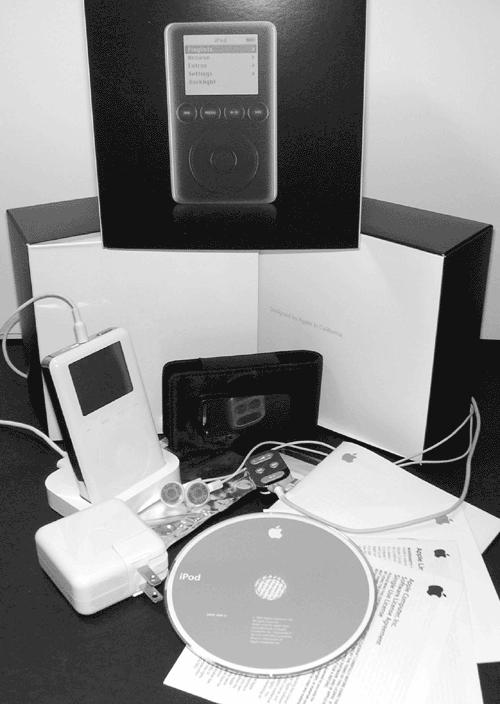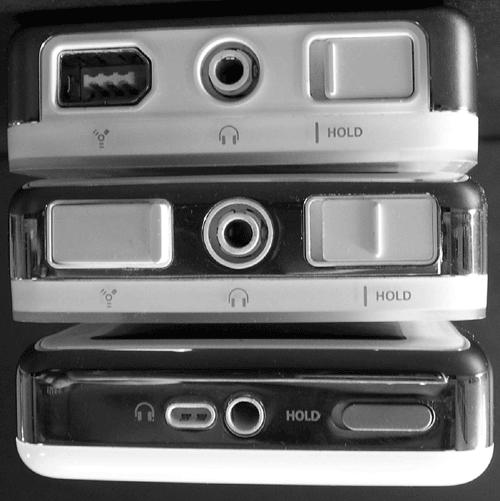Even before you extract it from its box, the iPod makes a design statement. Its shrink-wrapped cardboard cube opens like a book, revealing elegantly packaged accessories and software nestled around the iPod itself.
The first part of this book will familiarize you with the hardware portion of this parcel.
In addition to the nicely nestled iPod itself (Figure 1-1), the package’s compartments hold all the other stuff that comes with various iPod models: earbud-style headphones and their foam covers, the connection cable for your computer, power adapter, dock, carrying case with belt clip, remote control, and software CD. All you get by way of instructions, though, is a small square folder, including the short iPod User’s Guide. Good thing you have the book in your hands to fill in the gaps.
Figure 1-1. After the outer sleeve (top) is removed, the artfully designed packaging opens up to reveal the inner iPod. (Don’t be deceived by the black-looking iPod photo. That’s supposed to show what the thing looks like in the dark. There’s no such thing as a black iPod—at least not yet, although a company called Colorware will sell you a hand-painted Pod at http://www.colorwarepc.com. (And you can always indulge your color whims with an iPod Mini.) The iPod comes with all the hardware and software you need to get up and running, but the choice of music to put on it is up to you. If your iPod model didn’t come with all the accessories shown, you can probably find most of them for sale on the Web.
You’ll probably blow right past the warranty information (basically, you’re covered for one year) and the software agreement (the usual legalese that makes most people’s eyes glaze over like fresh Krispy Kreme doughnuts). The software agreement includes a small section about making digital copies of music, whose sentiment is echoed right on the iPod’s cellophane wrapping: Don’t steal music.
The monochrome LCD screen is your window into the iPod’s world. You can use it to navigate the menus, see how much of a charge the battery has left, and view the name of the current playlist or song. The display, whose resolution is 160 x 128 pixels, also comes with a white backlight, so you can still use your iPod in movies, concerts, and coal mines.
The concentric ring on the iPod’s face is the scroll wheel, which you use to navigate up or down lists of menu options on the screen. It lets you jump to a specific playlist, album, artist, song, or even a certain part of a song.
When a song is playing, you can also use the scroll wheel to adjust the iPod’s volume: Spin the wheel counterclockwise to turn the volume down, or clockwise to increase the sound.
Of course, “spin” may not quite be the right word. The wheel on the 2001 iPods actually turned. But on the 2002-and-later iPods, including the iPod Mini, the turning wheel gave way to a stationary touchwheel, which you operate by dragging your finger around the ring. You’ve got one less moving part to go bad.
Tip
Want to personalize your Pod forever? Say it with lasers—laser engraving, that is. You can immortalize the chrome backside of your iPod with a short, two-line message of your choosing for an extra $19 when you order an iPod at http://store.apple.com.
Just don’t make a typo.
The first generations of iPod had raised, contoured control buttons—Menu, ![]()
![]() , and so on—hugging the outer edge of the wheel.
, and so on—hugging the outer edge of the wheel.
Beginning with the 2003 iPods, Apple made all the buttons nonmoving, touch-sensitive parts (Figure 1-2). This design offers two advantages: It keeps sand and dirt from derailing the iPod’s parts, and it lets a red-orange glow backlight the names of the buttons when it’s dark out. Many iPodders complained, though, that the new layout makes it more of a thumb reach to hit the ![]() and
and ![]() buttons without bringing in a second hand.
buttons without bringing in a second hand.
Figure 1-2. Pressing any button turns on the iPod. The original iPod design (left) had the control buttons around the scroll wheel. On later iPods (middle), the control buttons are above the scroll wheel. The iPod Mini (right) puts the controls on a springy “click wheel” that combines the tactile response of the original iPods with the smooth surface of the wheel.
Owners of the iPod Mini don’t have to worry about that; its buttons are actual, clickable spots on the 12, 3, 6, and 9 o’clock positions on the scroll wheel. If you’re old enough to own an iPod, your thumb can probably reach them.
In any case, no matter which model you have, no matter where the control buttons have migrated, they all work the same way once you find them.
Starting from the center, here are the controls:
Select. The big white button in the center of any iPod is the Select button. Like clicking a mouse on a desktop computer, you press Select to choose a highlighted menu item. When a song title is highlighted, the Select button begins playback.
Menu. On early-model iPods and on the Mini, the Menu button is at 12 o’clock, up at the top of the circle. On current full-size iPods, Menu is the second button in the row of controls.
Pressing the Menu button once takes you to the iPod’s main screen, which gives you five options: Playlists, Browse, Extras, Settings, and Backlight. They’re described in more detail later in this chapter. (If you haven’t updated your iPod’s system software in a while—see Section 15.8—you may see a slightly different list. See Chapter 15 for more on software updates.)
The Menu key is also your ticket home: If you’ve burrowed deep into the iPod’s menu system, pressing the Menu key repeatedly takes you back one screen at a time until you’re back where you started.
Tip
The Menu button also controls the white backlight for the iPod’s display screen. Hold it down for a few seconds to turn the backlight on or off. Of course, you can also scroll to the Backlight item on the iPod’s main menu (as found in iPod system software 1.3 and later) and select Backlight there, too.
 and
and
 . You press the Next/Fast-forward button (represented in this book by this symbol
. You press the Next/Fast-forward button (represented in this book by this symbol  ) once to advance to the next song on the playlist. You can also hold it down to fast-forward through the current song to get to the good parts.
) once to advance to the next song on the playlist. You can also hold it down to fast-forward through the current song to get to the good parts.The Previous/Rewind button (
 ), of course, does the opposite: Press it once quickly to play the current song from the beginning; press it repeatedly to cycle back through the songs on the playlist. Hold it down to rewind through the current song, just like the Rewind button on your old tape deck.
), of course, does the opposite: Press it once quickly to play the current song from the beginning; press it repeatedly to cycle back through the songs on the playlist. Hold it down to rewind through the current song, just like the Rewind button on your old tape deck.
 . The Play/Pause button, marked by a black triangle (
. The Play/Pause button, marked by a black triangle ( ) and the universal Pause symbol (
) and the universal Pause symbol ( ), plays or stops the selected song, album, playlist, or library. It’s also the iPod’s Off switch if you press it for three seconds. (The iPod also turns itself off automatically after two minutes of inactivity.)
), plays or stops the selected song, album, playlist, or library. It’s also the iPod’s Off switch if you press it for three seconds. (The iPod also turns itself off automatically after two minutes of inactivity.)
Tip
These buttons, used in combination, also let you reset a locked-up iPod. Details in Chapter 15.
Here are the various switches and connectors you’ll find on the top and bottom of your iPod, as shown in Figure 1-3:
FireWire port. This is where you plug in the FireWire cable that came with your player. In most cases, you can connect the iPod directly to the computer’s FireWire connector both to charge the battery and to download music and data. (Some iPod models come with a white plastic cap that covers the FireWire port.)
You’ll find much more detail on this syncing business in Chapter 2.
Note
When you’re away from the computer, there’s another way to charge up your iPod: Attach the cable to the included AC power adapter and plug it into the wall. You have to use this technique, by the way, if the FireWire adapter card for your PC doesn’t supply power.
The 2003-and-later iPods, including the iPod Mini, have a nonstandard connector for supplying power to the iPod. It’s still a FireWire cable in most cases, but it has a flat connector that can plug right into the bottom of the iPod—or into the spiffy dock that comes with certain models.
Headphone port. On the iPod’s top, you’ll find the jack where you plug in the earbud-style headphones that come with your iPod.
Fortunately, this is a standard 3.5mm stereo plug. In other words, you’re free to substitute any other Walkman-style headphones, or even to play the music on the iPod through your home sound system (Chapter 12).
Remote control jack. On the 2003-and-later iPods, including the Mini, there’s an extra little port right next to the headphone jack. This small oval notch is for the remote control, which is a two-pronged affair.
Hold switch. With all the control buttons on the front of the iPod, it’s easy to hit one accidentally while you’re taking it in or out of your pocket or purse. To prevent such unintended button activity, slide the iPod’s Hold switch over to reveal a bright orange bar. You’ve just disabled all the buttons on the front of the unit, preventing accidental bumps. (A small lock icon appears on the iPod’s screen when the Hold button is on.) Slide the switch back to turn off the Hold function.
Figure 1-3. The headphone jack in the center and the Hold switch on the right side have remained up top in all generations of the iPod, but the FireWire port has roamed. The original 2001 iPod (top) is wider than later models and has no plastic cover for the FireWire port like the 2002 iPod (middle) does. The 2003 iPod (bottom) and the iPod Mini (not shown) has a remote jack closely aligned with the headphone port in the center. The Hold switch is still off to the right, but the FireWire port has changed shape and migrated to the bottom of the device.
Get iPod & iTunes: The Missing Manual, Second Edition now with the O’Reilly learning platform.
O’Reilly members experience books, live events, courses curated by job role, and more from O’Reilly and nearly 200 top publishers.




